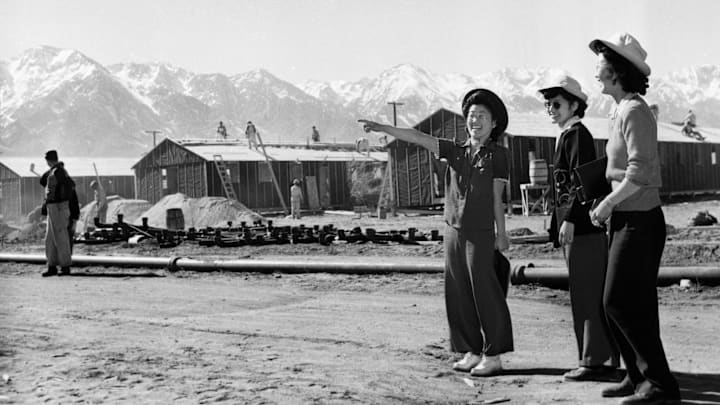On February 19, 1942, President Franklin D. Roosevelt issued Executive Order 9066, which authorized American military personnel to incarcerate Japanese Americans in the U.S. for fear they would be loyal to Imperial Japan in the wake of the attack on Pearl Harbor. Today, more than 80 years later, the Irei Project—a nonprofit dedicated to preserving the memories of individuals who were held in these WWII concentration camps—has teamed with Ancestry.com to publish the names of 125,284 people detained in those camps. This digitized, free-to-access list is the most comprehensive of its kind.
Beginning in 2019, Irei Project director Duncan Ryūken Williams painstakingly researched information about the detainees, turning the list of names into a book that became an interactive exhibit at the Japanese American National Museum in Los Angeles. Participants were able to use a hanko stamp—a carved stamp that is used to represent a person’s identity—to mark a small blue dot below detainees’ names as a means of honoring them. Irei also has a beautiful scrolling wall of the names organized by birth year on their site.
In addition to the names, more than 350,000 historical documents related to Japanese incarceration are also available on Ancestry—a site Williams used extensively during a challenging research process that often found him contending with smudged documents, multiple spellings, and missing records.
“You can’t honor people if their names are spelled wrong,” Williams wrote in a blog post announcing the list’s publication. He used the 1940 census, draft cards, marriage certificates, and other official government documents to verify the correct spelling of each detainee’s name.
The most famous example of literally dotting i’s and crossing t’s is Star Trek’s George Takei, who was incarcerated as a young boy alongside more than 8000 other Japanese Americans at the Rohwer Relocation Center in Tillar, Arkansas. Camp records listed him as “Hosato George Takei” while records from the Tule Lake Relocation Center in Newell, California, listed him as “Hozato George Takei.” Williams used Takei’s birth certificate to properly list him as “Hosato” in the registry.
In addition to the list of names, the Irei Project also has plans for memorial displays at some of the relocation camps and a memorial statue at the Japanese American National History Museum.
“This project is not a static nor complete one,” Williams wrote on Ancestry. “The premise of the Irei Project is that we need the public to make sure we not only remember the injustice of the incarceration, but their help in repairing the wounds of that history. By accurately recording the details of those who were incarcerated during this time, we continuously correct the historical record for generations to come.”
